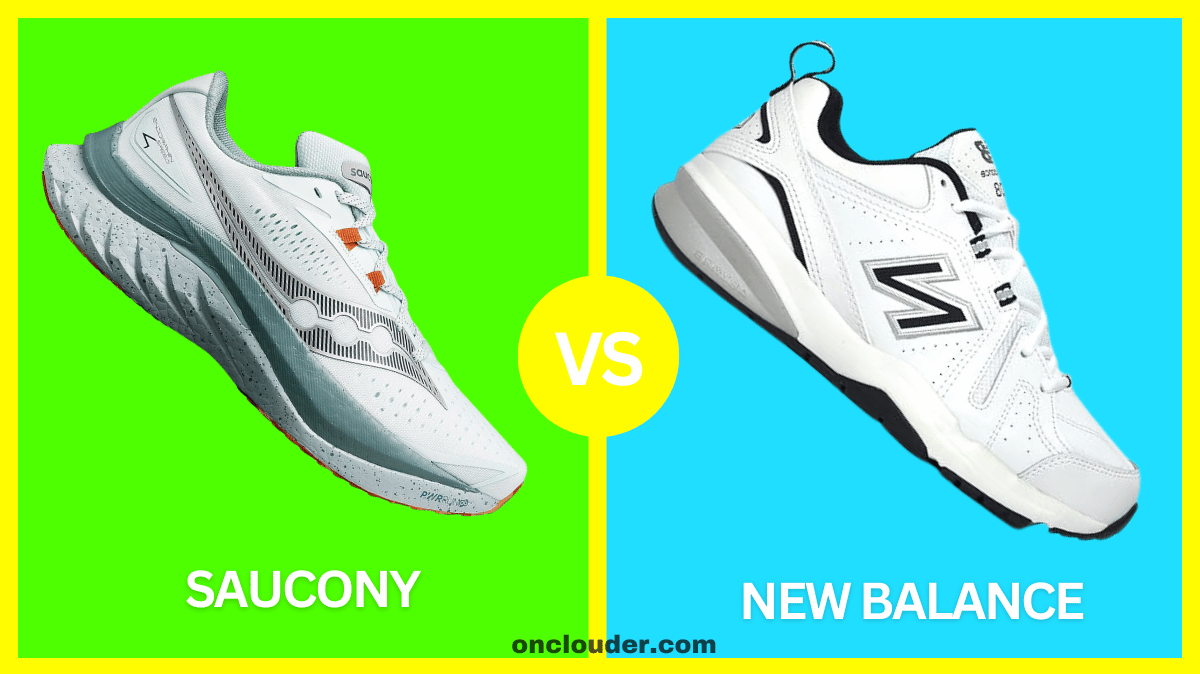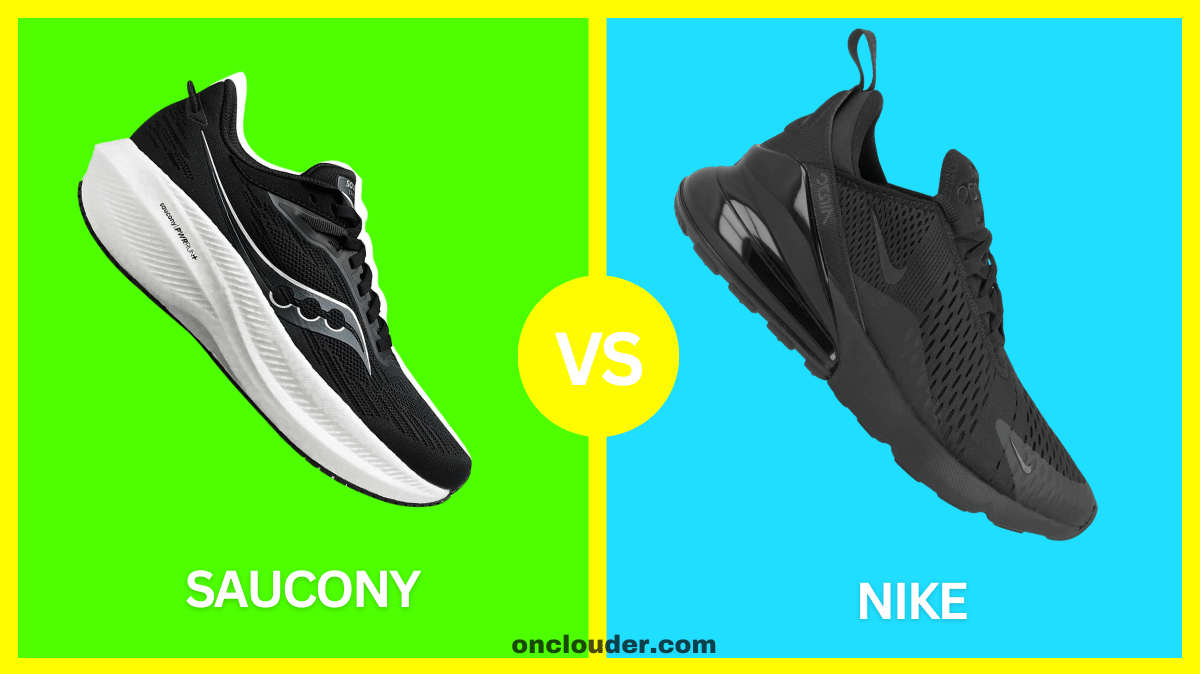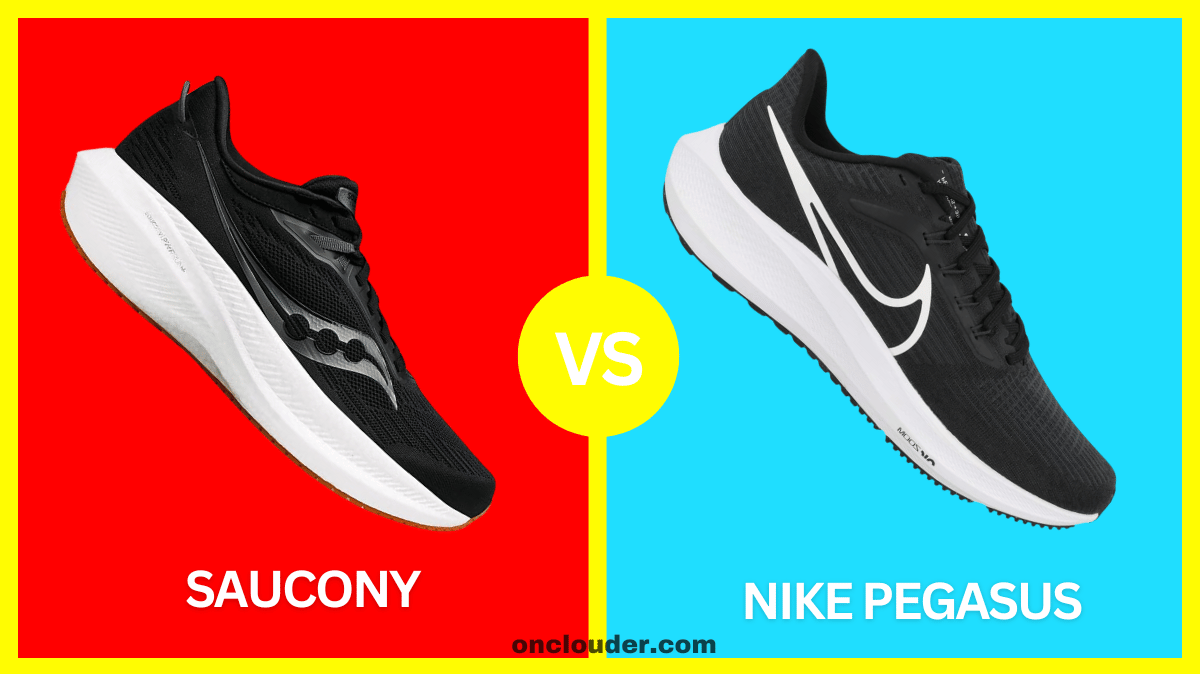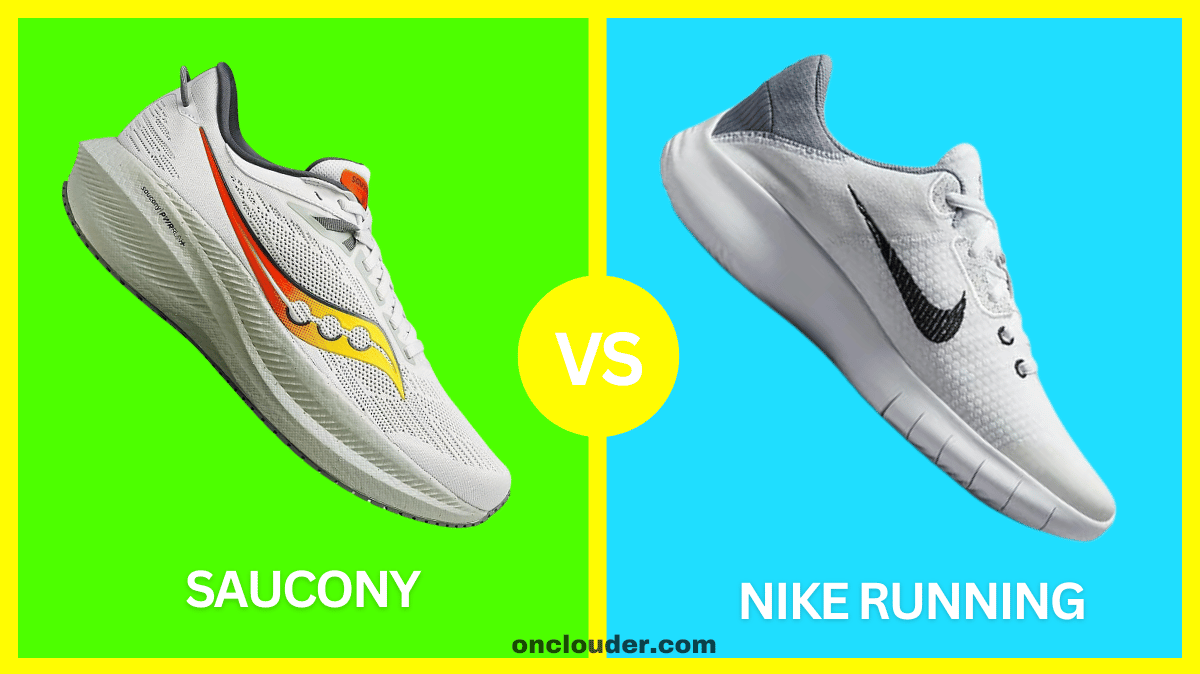Are you looking for a new pair of running shoes but can’t decide between Saucony and New Balance? Don’t worry! We’re here to help you figure out which brand might be the best fit for your feet.
Both Saucony and New Balance are popular choices among runners, but they have some key differences that might make one a better pick for you.
We’ll compare Saucony and New Balance shoes across various important factors like comfort, durability, and style.
By the end, you’ll have a clearer idea of which brand could be your perfect running companion.
So, let’s lace up and dive in!
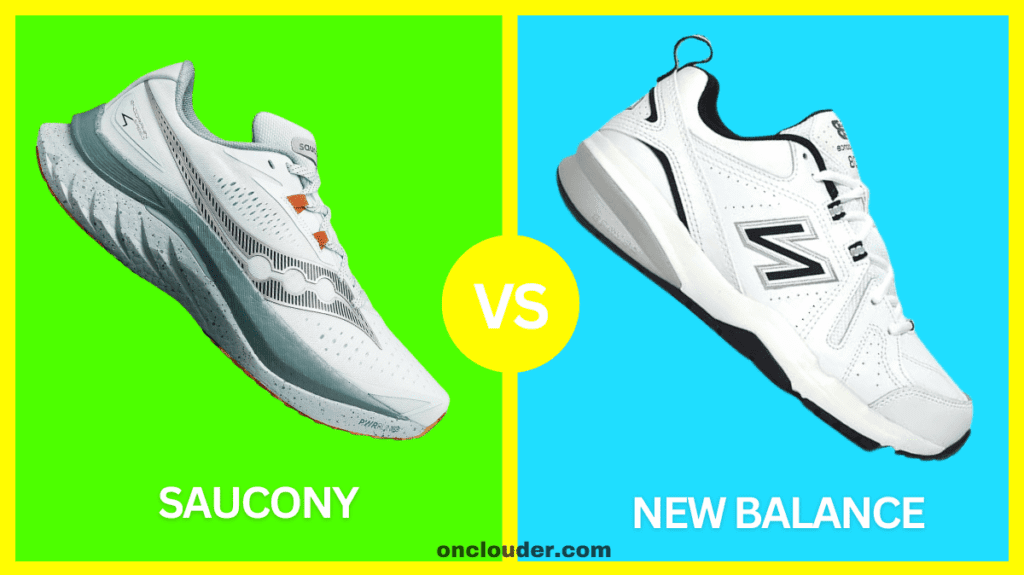
Contents
- 1 Quick Comparison: Saucony vs New Balance Shoes
- 2 A Quick Look at Saucony and New Balance
- 3 Comfort: Which Feels Better on Your Feet?
- 4 Durability: Which Shoes Last Longer?
- 5 Breathability: Keeping Your Feet Cool
- 6 Cushioning: Softness and Support
- 7 Shoe Fit: Finding Your Perfect Match
- 8 Stability: Keeping You Steady
- 9 Quality: Built to Last
- 10 Style: Looking Good While You Run
- 11 Size Range: Finding Your Fit
- 12 Materials: What Are They Made Of?
- 13 Weight: Light on Your Feet
- 14 Flexibility: Bending with Your Foot
- 15 Water Resistance: Staying Dry
- 16 Sole: Where the Rubber Meets the Road
- 17 User Reviews: What Do Runners Say?
- 18 Price: What’s Your Budget?
- 19 Pros and Cons
- 20 Conclusion
- 21 Frequently Asked Questions
Quick Comparison: Saucony vs New Balance Shoes
The main difference between Saucony and New Balance shoes is their fit and cushioning. Saucony shoes often have a snugger fit and firmer cushioning, making them feel more responsive when you run.
New Balance shoes usually have a wider fit and softer cushioning, which can feel more comfortable for some people. Both brands make good running shoes, but they feel different on your feet.
Now, let’s create a detailed comparison table for Saucony vs New Balance Shoes:
| Feature | Saucony | New Balance |
|---|---|---|
| Fit | Snugger, especially in the midfoot | Wider options available |
| Cushioning | Firmer, more responsive | Softer, more plush |
| Weight | Generally lighter | Varies, some models heavier |
| Style | Modern, bold designs | Mix of classic and modern looks |
| Size Range | Good range, some wide options | Extensive range, many width options |
| Price | Slightly higher on average | Often more budget-friendly options |
| Durability | Good, typically 300-500 miles | Very good, some models last 500+ miles |
| Best For | Speed-focused runners, narrower feet | Comfort-focused runners, wider feet |
In summary: Saucony and New Balance both make great running shoes, but they’re a bit different. Saucony shoes are often lighter and feel more “zippy” when you run. They’re good if you like to feel the ground and go fast.
New Balance shoes usually feel softer and come in more sizes. They’re great if you want super comfy shoes or have trouble finding shoes that fit. Try both to see which feels best on your feet!
A Quick Look at Saucony and New Balance
Before we get into the details, let’s start with a brief introduction to both brands:
Saucony: The Speedy Challenger
Saucony (pronounced “sock-uh-nee”) has been making shoes since 1898. They’re known for creating lightweight, fast shoes that many runners love. Saucony focuses on making shoes that help you run efficiently and comfortably.
New Balance: The Comfort King
New Balance has been around since 1906. They’re famous for their comfortable shoes that come in a wide range of sizes and widths. New Balance prides itself on making shoes that fit well and feel great, no matter what shape your feet are.
Now that we’ve met our contenders, let’s see how they stack up against each other in different categories.
Comfort: Which Feels Better on Your Feet?
When it comes to running shoes, comfort is king. After all, you want your feet to feel good mile after mile. Both Saucony and New Balance offer comfortable shoes, but they approach comfort in slightly different ways.
Saucony’s Comfort
Saucony shoes often feel snug and responsive. They’re designed to hug your feet and provide a springy feel that can make you feel faster. Many runners say Saucony shoes feel like an extension of their feet.
New Balance’s Comfort
New Balance is all about that plush, cushioned feel. Their shoes often have thick, soft soles that absorb shock well. If you like feeling like you’re running on clouds, New Balance might be your go-to.
The Comfort Verdict
Both brands offer comfortable shoes, but New Balance might have a slight edge for runners who prefer a softer, more cushioned feel. Saucony could be better for those who like a more responsive, close-to-the-ground sensation.
Durability: Which Shoes Last Longer?
Nobody wants their running shoes to wear out quickly. Let’s see how Saucony and New Balance compare when it comes to durability.
Saucony’s Durability
Saucony shoes are generally well-made and can handle a lot of miles. They use tough materials in high-wear areas to help the shoes last longer. Many runners report getting 300-500 miles out of their Saucony shoes before needing to replace them.
New Balance’s Durability
New Balance also has a reputation for making durable shoes. They often use high-quality materials that can withstand lots of running. Some New Balance models are known to last even beyond 500 miles for some runners.
The Durability Verdict
Both brands make shoes that can go the distance. New Balance might have a slight advantage in overall durability, but it can vary depending on the specific shoe model and how you run.
Breathability: Keeping Your Feet Cool
Nobody likes sweaty, uncomfortable feet when running. Let’s see how these brands handle breathability.
Saucony’s Breathability
Saucony often uses lightweight, breathable materials in their upper designs. Many of their shoes have mesh or knit uppers that allow air to flow freely, keeping your feet cool and dry.
New Balance’s Breathability
New Balance also prioritizes breathability in their designs. They use similar materials to Saucony, with mesh and knit uppers being common. Some New Balance shoes even have specially designed ventilation zones.
The Breathability Verdict
Both brands do a good job at keeping your feet cool. The difference in breathability often comes down to specific shoe models rather than the brand as a whole.
Cushioning: Softness and Support
Cushioning can make a big difference in how comfortable your run feels. Let’s compare the cushioning approaches of Saucony and New Balance.
Saucony’s Cushioning
Saucony uses various cushioning technologies, including their PWRRUN and PWRRUN+ foams. These tend to provide a balance of softness and responsiveness. Saucony shoes often have a firmer feel compared to some other brands.
New Balance’s Cushioning
New Balance is known for their plush cushioning. They use technologies like Fresh Foam and FuelCell to provide soft, bouncy rides. Many New Balance shoes offer a lot of cushioning, which can be great for longer runs or if you prefer a softer feel.
The Cushioning Verdict
If you like a lot of soft cushioning, New Balance might be your best bet. If you prefer a firmer, more responsive feel, Saucony could be the way to go.
Shoe Fit: Finding Your Perfect Match
Getting the right fit is crucial for comfortable and effective running. Here’s how Saucony and New Balance approach fit:
Saucony’s Fit
Saucony shoes tend to have a snugger fit, especially in the midfoot area. They often work well for runners with narrow to average-width feet. However, Saucony does offer some models in wide sizes for those who need more room.
New Balance’s Fit
New Balance is famous for offering a wide range of sizes and widths. They have shoes for narrow feet, wide feet, and everything in between. This makes New Balance a popular choice for runners who struggle to find shoes that fit well.
The Fit Verdict
If you have average to narrow feet, both brands could work well. But if you have wide feet or need special sizes, New Balance might offer more options.
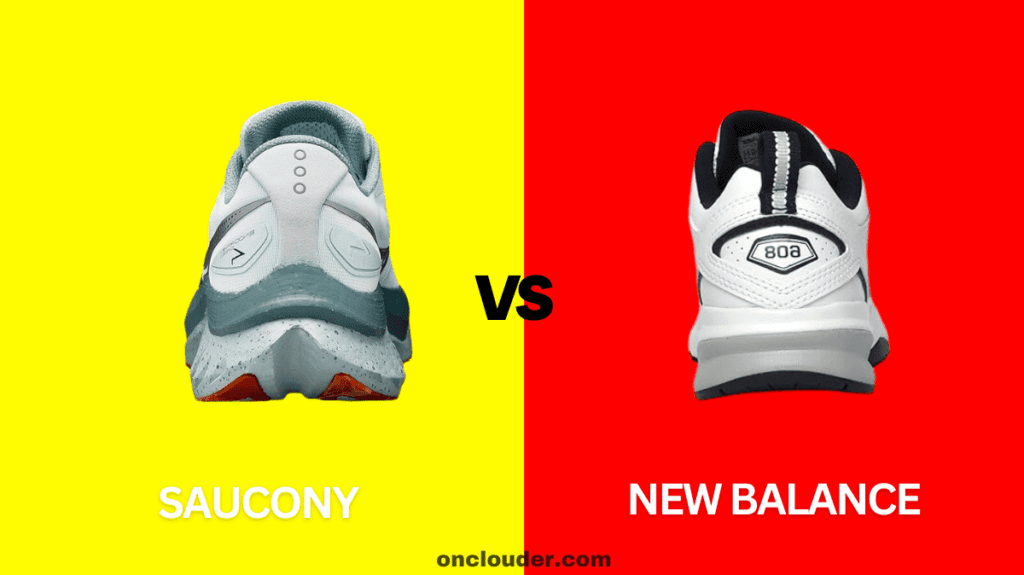
Stability: Keeping You Steady
Some runners need extra support to help prevent their feet from rolling inward too much (overpronation). Let’s see how these brands handle stability.
Saucony’s Stability
Saucony offers several stability shoe models, like the Guide and Hurricane series. These use technologies like medial posts or guided support to help control overpronation.
New Balance’s Stability
New Balance also has a range of stability shoes, including popular models like the 860 series. They use various technologies to provide support, including their T-Beam support system.
The Stability Verdict
Both brands offer good stability options. The best choice will depend on your specific needs and how the shoes feel on your feet.
Quality: Built to Last
Quality goes hand in hand with durability, but it’s also about how well the shoes are made overall.
Saucony’s Quality
Saucony is known for producing high-quality shoes. They use good materials and pay attention to details in construction. Many runners praise the overall quality of Saucony shoes.
New Balance’s Quality
New Balance also has a strong reputation for quality. They’re particularly known for their commitment to quality control, especially in their shoes made in the USA or UK.
The Quality Verdict
Both brands are known for making quality shoes. You’re unlikely to be disappointed with the quality from either Saucony or New Balance.
Style: Looking Good While You Run
While performance is most important, it’s nice to have shoes that look good too!
Saucony’s Style
Saucony tends to have a sleek, modern look. They often use bold color combinations and have some eye-catching designs. If you like shoes that stand out, Saucony might appeal to you.
New Balance’s Style
New Balance has a mix of classic and modern designs. They’re known for their retro-style sneakers that are popular for casual wear as well as their performance running shoes. New Balance often offers more subdued color options.
The Style Verdict
Style is subjective, but if you prefer bold, modern looks, you might lean towards Saucony. If you like classic styles or more subtle designs, New Balance could be your pick.
Size Range: Finding Your Fit
Having the right size is crucial for comfortable running. Let’s see how these brands handle sizing.
Saucony’s Size Range
Saucony offers a good range of sizes, typically from US men’s 7 to 15 and women’s 5 to 12. They also offer some models in wide widths.
New Balance’s Size Range
New Balance is known for their extensive size range. They offer sizes from US men’s 6 to 20 and women’s 5 to 13. They also provide multiple width options, from narrow to extra-wide.
The Size Range Verdict
While both brands offer a good range of sizes, New Balance has the edge here, especially if you need unusual sizes or widths.
Materials: What Are They Made Of?
The materials used in running shoes can affect comfort, durability, and performance.
Saucony’s Materials
Saucony uses a variety of high-quality materials. Their uppers often feature engineered mesh or knit fabrics for breathability. For cushioning, they use proprietary foams like PWRRUN and PWRRUN+.
New Balance’s Materials
New Balance also uses quality materials. They’re known for their Fresh Foam and FuelCell cushioning technologies. Their uppers often use mesh and knit materials, sometimes with added overlays for support.
The Materials Verdict
Both brands use good quality materials. The best choice may depend on which specific materials feel best to you.
Weight: Light on Your Feet
Lighter shoes can help you feel faster and reduce fatigue during long runs.
Saucony’s Weight
Saucony tends to make lightweight shoes. Many of their popular models weigh less than 10 ounces for a men’s size 9.
New Balance’s Weight
New Balance shoes can vary more in weight. They have some very lightweight options, but also some heavier, more cushioned models.
The Weight Verdict
If you prioritize lightweight shoes, Saucony might have a slight advantage overall. However, both brands offer light options.
Flexibility: Bending with Your Foot
Flexible shoes can help your foot move more naturally as you run.
Saucony’s Flexibility
Saucony shoes often offer a good balance of flexibility and support. Many of their shoes flex easily in the forefoot while providing stability in the midfoot.
New Balance’s Flexibility
New Balance shoes can vary in flexibility. Some models are quite flexible, while others prioritize stability and may be a bit stiffer.
The Flexibility Verdict
Both brands offer flexible options, but Saucony might have a slight edge in this category overall.
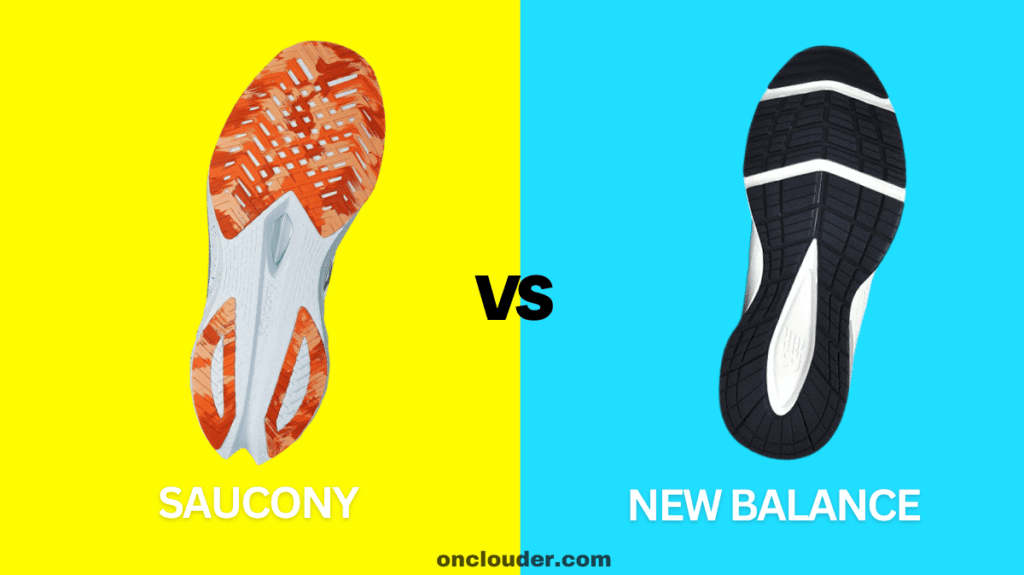
Water Resistance: Staying Dry
While not all running shoes are waterproof, some level of water resistance can be helpful.
Saucony’s Water Resistance
Saucony offers some waterproof models in their trail running line, using technologies like GORE-TEX. Their road running shoes generally aren’t waterproof but may offer some water resistance.
New Balance’s Water Resistance
New Balance also offers waterproof options, particularly in their trail running shoes. Like Saucony, their road shoes aren’t typically waterproof but may resist light moisture.
The Water Resistance Verdict
Both brands are fairly similar in this category, offering waterproof options for trail running but not typically for road running.
Sole: Where the Rubber Meets the Road
The sole of a running shoe is crucial for traction, cushioning, and durability.
Saucony’s Sole
Saucony often uses high-quality rubber compounds in their outsoles for good traction and durability. Their midsoles feature their proprietary cushioning foams.
New Balance’s Sole
New Balance also uses durable rubber in their outsoles. They’re known for their thick, cushioned midsoles, especially in models featuring their Fresh Foam technology.
The Sole Verdict
Both brands offer quality soles. Saucony might have an edge in responsiveness, while New Balance could win for cushioning.
User Reviews: What Do Runners Say?
Let’s take a look at what other runners think about these brands:
| Brand | Average Rating | Number of Reviews |
| Saucony | ⭐⭐⭐⭐⭐ 4.5/5 stars | 10,000+ |
| New Balance | ⭐⭐⭐⭐⭐ 4.4/5 stars | 15,000+ |
Both brands are highly rated by runners, with Saucony having a slightly higher average rating but New Balance having more total reviews.
Price: What’s Your Budget?
Running shoes are an investment in your health and comfort. Here’s how these brands compare in price:
| Brand | Entry-Level Price | Mid-Range Price | Premium Price |
| Saucony | $80-$100 | $120-$140 | $150-$180 |
| New Balance | $70-$90 | $110-$130 | $140-$170 |
New Balance tends to offer slightly lower prices overall, but both brands have options at various price points.
Pros and Cons
| Brand | Pros ✅ | Cons ⚠️ |
|---|---|---|
| Saucony | Great for running | Less variety for casual wear |
| Lightweight and responsive | Fewer width options | |
| High-performance cushioning | Can be pricey for some models | |
| Good for narrow to average feet | May not suit wide feet well | |
| New Balance | Wide range of sizes and widths | Some models can be heavy |
| Good for various activities | Running shoes may be less specialized | |
| Classic, stylish designs | Cushioning may feel too soft for some | |
| Often more affordable options | So many choices can be overwhelming |
Conclusion
After comparing Saucony and New Balance across all these categories, it’s clear that both are excellent brands with a lot to offer. Your best choice will depend on your specific needs and preferences.
Choose Saucony if:
- You prefer a more responsive, close-to-the-ground feel
- You like lightweight shoes
- You want a sleek, modern style
Choose New Balance if:
- You prefer soft, plush cushioning
- You need wide sizes or have trouble finding shoes that fit
- You like classic styles and more subdued colors
Remember, the most important thing is how the shoes feel on your feet. If possible, try on shoes from both brands to see which feels best for you. Happy running!
Frequently Asked Questions
Are Saucony or New Balance shoes better for flat feet?
Both brands offer good options for flat feet. Look for stability shoes from either brand.
Do Saucony and New Balance shoes run true to size?
Generally yes, but it can vary by model. It’s always best to try shoes on or check size guides.
Which brand is better for marathon running?
Both brands offer excellent marathon shoes. Saucony’s Endorphin Pro and New Balance’s FuelCell RC Elite are popular choices.
Are Saucony or New Balance shoes good for casual wear?
Both can be great for casual wear, but New Balance is particularly popular for lifestyle sneakers.
How often should I replace my Saucony or New Balance running shoes?
Generally, replace your shoes every 400-500 miles or every 4-6 months if you run regularly.

